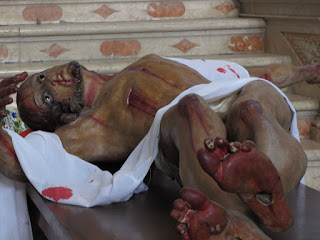
The scrub brush fields near the church were on fire. We could see large flames reaching up into the trees and also a line of flames expanding. A very large area had already burned leaving a huge expanse of blackened earth. This is an area that is part of the Botanical Gardens of Brasília, and the fires burned a very large portion of the Gardens.

In the left side of this photo, there are the outlines of two men fighting the fires. The had very long poles with a flap of rubber and were using them smother flames. They looked like they were using giant fly swatters. I have never seen a tool like that used in fire control before. I didn't have my good camera with me so I was unable to get a close-up shot. We could also see stream of water being sprayed on flames that were consuming trees close to the school that is next to our church building.

About an hour and a half later, all that was left were a few smoldering patches near us, but there were clearly more fires burning in the distance.
On the way home from work Thursday evening, I could see a ring of fire along the ridge surrounding Lago Sul. It was an impressive sight, and I wish that I had had my camera with me.

Early Friday morning, Rebecca woke up because she was having difficulty breathing, a not uncommon occurrence due to her allergies, but then she realized that smoke had infiltrated the house, she got up to go through the house shutting windows and turning on fans. Our house and clothing smelled like we were on a campout.

I teach a religion class for high school kids before school, and all the seminary kids reported heavy smoke in their homes as well. Coincidentally, the topic of that morning's class was Sodom and Gomorrah, and the smoke and fires represented well the effects of fire and brimstone.

Other members of the Embassy had posted on facebook that CO alarms had gone off in some homes, and some families had gone to the Embassy to escape the smoke. The main part of Brasília is on the side of the lake opposite the location of the fires and up a higher so the smoke was not as intense there. A Brazilian friend that has lived in Lago Sul for 40 years said that he had ever seen smoke like this before.

I decided to take my camera with me to work and get some photos of the dense smoke. I could see that the smoke was even worse towards the neighborhoods closer to the JK bridge at the other end of the lake. I crossed over the middle bridge and stopped and took some photos from the ridge looking back towards Lago Sul.

The local news reported that well over one hundred fires were burning in the area. Though the total number of fires was less than last year, this was more than there had been at any one time. It has been very dry for several weeks, around 5% humidity, and it does not take much to start a fire. Some of them had started as controlled burns, others were the results of carelessness, like throwing cigarettes out a car window or from fireworks from various Independence Day parties. Even a ray of the sun passing through a broken piece of glass can get a fire going. The cooling of the air at night causes an inversion trapping the smoke near the ground and concentrating it in the low areas near the lake. When the sun rises, the air warms and the smoke rises and dissipates in the atmosphere.
By late Friday afternoon, the Embassy authorized voluntary evacuation to the higher areas of Brasília and approved hotel reimbursements. We chose to stay at home since we were busy preparing for birthday parties and half the kids were scattered at various locations about town. By the time we got everyone back together, it was late and we were tired, so we didn't want to bother with trying to find a hotel room and moving the entire family across town. With all the AC units running all day, the smoke seemed to have cleared from the bedrooms enough that we were able to sleep well.
Location:Brasília, Brazil






























